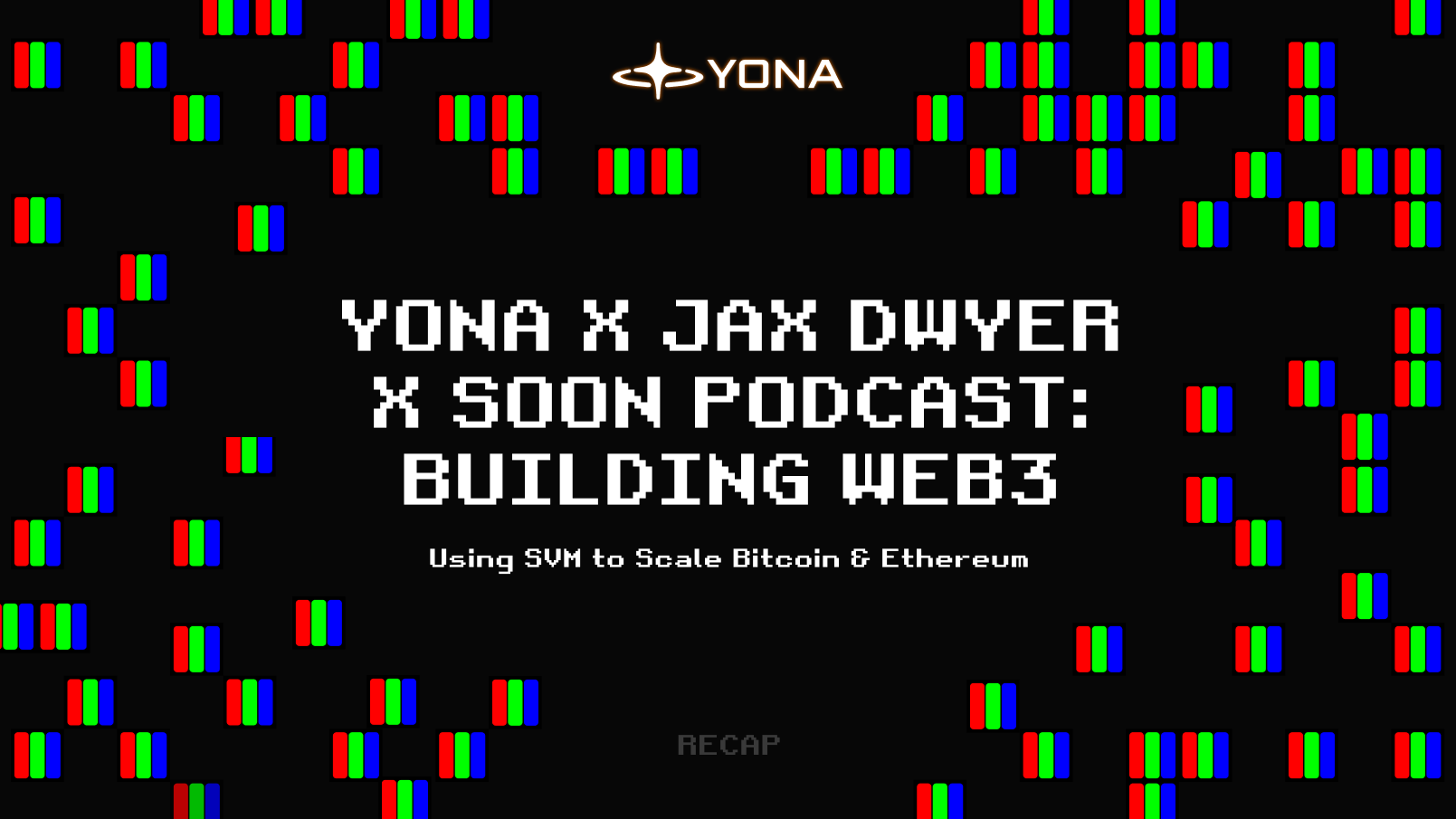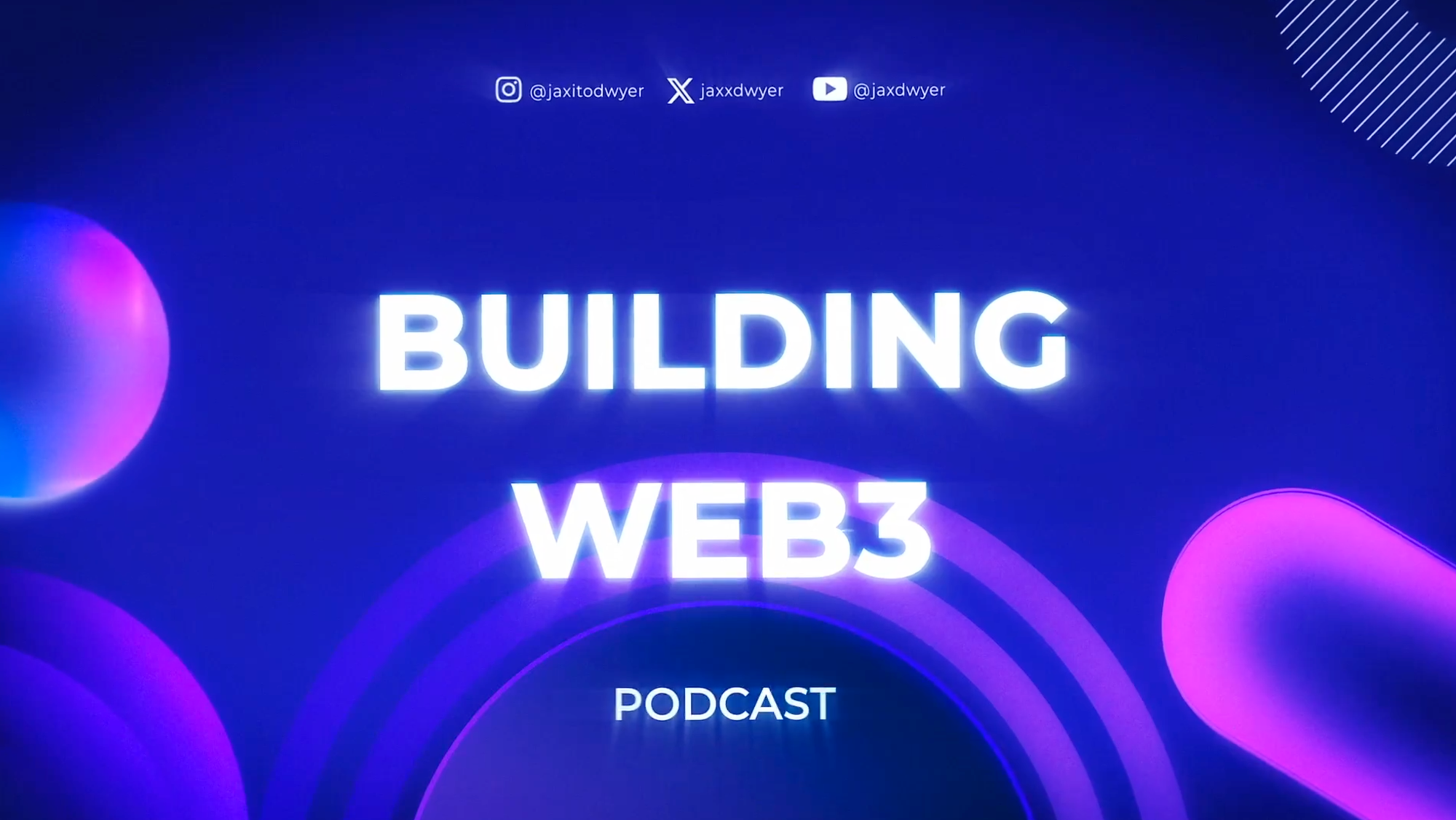Using Solana Virtual Machine to Scale Bitcoin and Ethereum: Insights from the Building Web3 Podcast


Introduction
The blockchain landscape has witnessed substantial evolution, with Ethereum and Bitcoin leading the way as foundational Layer 1 (L1) networks. However, scalability, high fees, and fragmented liquidity remain persistent challenges. Solana's Virtual Machine (SVM) emerges as a groundbreaking alternative, enabling high-speed parallel transaction execution, offering flexibility for cross-chain operations, and reshaping the developer experience.
Joanna Zeng and Max provide firsthand insights into their respective projects, Soon and Yona Network, which leverage the SVM for scaling Bitcoin and Ethereum. They discuss the merits of adopting SVM, the challenges of integrating it into established ecosystems, and the paradigm shift it represents in blockchain scalability.

1. SVM Technological Edge
Joanna and Max explain how SVM differs from Ethereum's EVM and other Layer 2 (L2) scaling solutions. Unlike EVM, which relies on sequential transaction processing, SVM utilizes parallel execution, allowing for a significant increase in transactions per second (TPS) and lower latency. This parallelization ensures real-time performance, making it ideal for decentralized applications (dApps) in gaming, decentralized AI, and financial services.
Key Technical Advantages:
- High-Speed Execution: SVM achieves block finality within 50 milliseconds, compared to Ethereum's two seconds.
- Developer-Friendly Architecture: Programs deployed on Solana can be seamlessly ported to other SVM chains without modifications.
- Interoperability: SVM’s architecture enables cross-chain applications to interact smoothly across Solana, Ethereum, and Bitcoin ecosystems.
Max highlights how Yona Network uses SVM to build a blockchain that executes on Solana’s performance layer while settling on Bitcoin. This approach marries Bitcoin's liquidity and security with Solana's speed, enabling new use cases for idle Bitcoin assets.
2. Challenges with EVM-Based Scaling Solutions
Joanna critiques Ethereum’s Layer 2 scaling strategy, which relies heavily on rollups and sidechains. While these solutions increase throughput, they have introduced issues like liquidity fragmentation and inconsistent developer experiences. She notes that the proliferation of over 150 OP stack chains has led to inefficiencies rather than true innovation.
Challenges of Ethereum’s Current Ecosystem:
- Fragmented Liquidity: Multiple rollups dilute liquidity, making composability between dApps challenging.
- Limited Use Cases: Many rollups replicate Ethereum's functionality without leveraging the unique advantages of modular architecture.
- Technical Bottlenecks: EVM's sequential processing limits its ability to support high-demand applications like AI and gaming.
SVM, as Joanna notes, overcomes these challenges by offering a unified execution environment with unparalleled speed and reliability. Soon uses SVM to develop rollup chains that integrate with Ethereum’s L1, ensuring minimal fragmentation while leveraging Ethereum's extensive liquidity.
3. Bridging Solana, Ethereum, and Bitcoin
The podcast highlights how SVM is bridging previously isolated blockchain ecosystems. Joanna introduces Soon’s "InterSoon" framework, which facilitates asset transfers and cross-chain messaging between Solana, Ethereum, and Ton. Meanwhile, Max discusses Yona Network’s focus on bringing SVM’s execution layer to Bitcoin, a notoriously difficult blockchain to build on due to its lack of native smart contract functionality.
Interoperability Initiatives:
- Soon’s InterSoon Protocol: Creates asset bridges between Solana and Ton, with plans to expand to Ethereum. This enables seamless cross-chain liquidity and composability.
- Yona’s Bitcoin Integration: Combines Bitcoin’s liquidity with SVM’s high-performance execution to create new opportunities for Bitcoin-based dApps.
Both projects emphasize the importance of interoperability in fostering a more cohesive blockchain ecosystem while maintaining the unique characteristics of each L1.
4. The Developer Experience
A recurring theme in the podcast is the evolution of developer tooling and the role it plays in SVM adoption. Max and Joanna both highlight that SVM development is no longer the "glass chewing" experience it once was. With tools like Anchor and TipLink, alongside better documentation and libraries, SVM has become accessible to developers from both native Solana and external ecosystems like Cosmos, Polkadot, and Near.
Developer Onboarding Strategies:
- Leverage Existing Tools: Programs built for Solana can be easily ported to other SVM chains.
- Custom Infrastructure: Soon and Yona have built tailored tools and infrastructure to onboard developers from Ethereum and Bitcoin ecosystems.
- Community Building: Both projects run hackathons and educational initiatives to attract new developers to the SVM space.
Use Cases and Implications
1. Decentralized AI and Gaming
SVM’s low-latency execution is ideal for decentralized AI applications and gaming platforms, which require real-time performance. Joanna describes how Soon’s SVM-based rollups can support high-throughput gaming dApps with sub-50 millisecond latency.
2. DeFi Innovations
By integrating SVM with Ethereum and Bitcoin, projects like Soon and Yona unlock new DeFi opportunities, enabling seamless liquidity flows and novel financial instruments. This includes KYC-enabled app chains for institutional adoption.
3. Scalable Oracles
Projects like Pyth, which require high throughput and low latency, exemplify the need for app chains or network extensions built on SVM. These chains cater to specialized use cases while maintaining composability with general-purpose networks.
Conclusion
The integration of SVM into the broader blockchain ecosystem represents a significant step forward in addressing the scalability and fragmentation challenges of existing L1 and L2 solutions. By leveraging SVM’s high-speed parallel processing, interoperability capabilities, and developer-friendly tools, projects like Soon and Yona Network are pioneering a new era of blockchain innovation. This paradigm shift promises to unlock new possibilities for dApps, enhance developer productivity, and create a more cohesive and efficient decentralized ecosystem.
Future work will need to address the scalability of governance frameworks and ensure seamless interoperability as more projects adopt the SVM paradigm. As blockchain technology evolves, the collaboration between ecosystems like Solana, Ethereum, and Bitcoin will be pivotal in driving mass adoption and innovation.
About Yona Network
Yona is a real-time latency Bitcoin L2 blockchain enabling Web2 experience for dApps. We use custom hyper-optimized modularized SVM to achieve superior performance with less than 10ms latency and block time. Yona enables lightning-fast transactions and offers limitless scalability, paving the way for next-generation protocols tailored to enhance the user experience within the Bitcoin ecosystem.
Yona Network links:
Website | Documentation | Twitter | Discord | Blog

